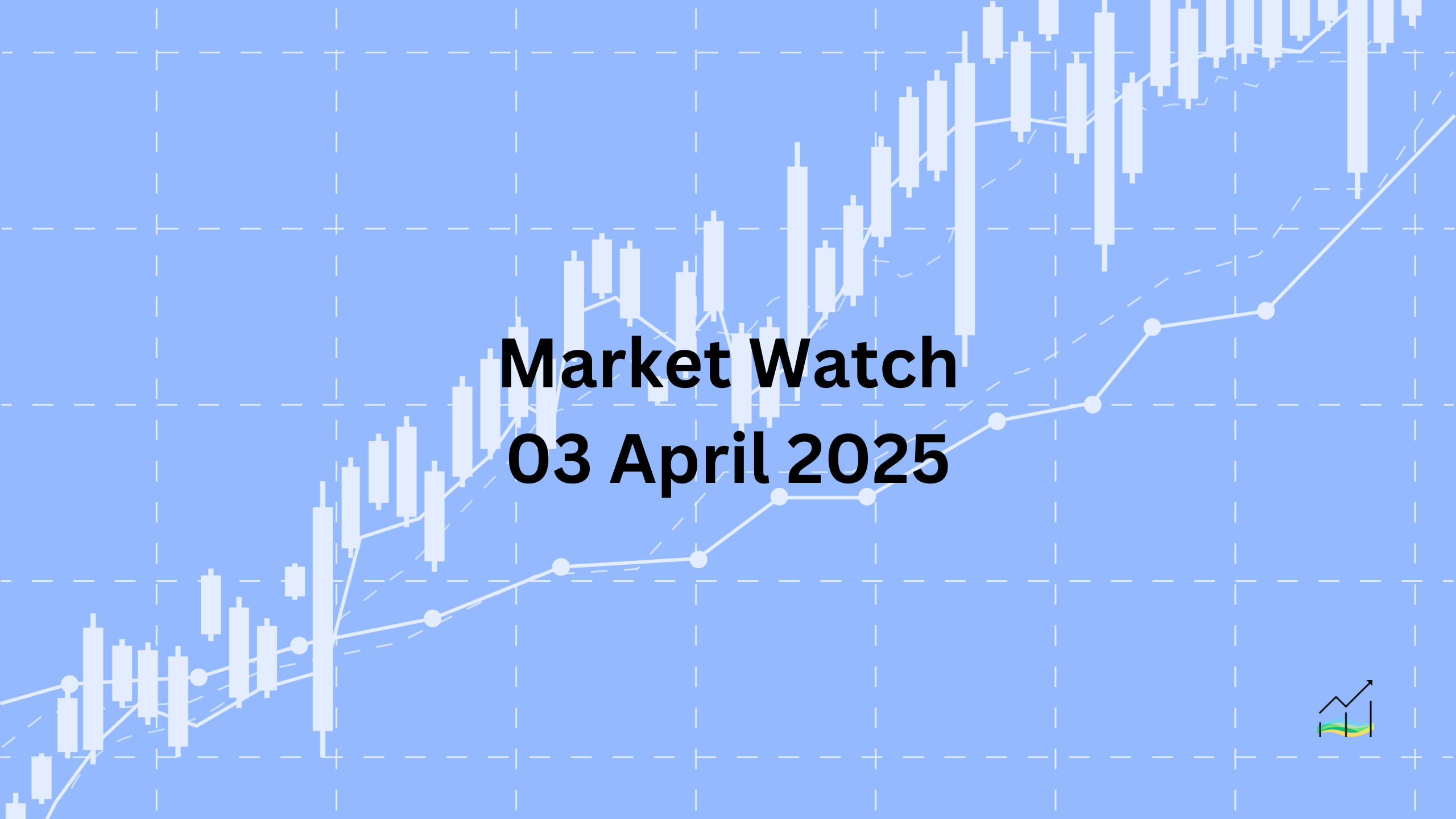03/04/2025 Market Watch

U.S. Trade Policy Shake-Up Sparks Market Turbulence
The latest trade measures announced by the US President are sending shockwaves through global markets, despite strong domestic economic indicators such as record-high household net worth. The newly enforced tariffs—framed as a move toward "kind reciprocity"—are triggering broad-based financial reactions, including sharp declines in equities, a selloff in the US dollar, and heightened volatility across commodities and bonds.
Despite the strength of the US economy, the administration claims the country has been exploited through global trade. Rather than adopting a detailed methodology, the new tariff policy appears to rest on a basic formula: if the US runs a trade deficit with another country, imports from that country are subject to new levies. The policy includes a minimum 10% tariff effective April 5 and an additional reciprocity levy beginning April 9. Even countries like Israel, which recently removed all tariffs on US imports, have not been spared—facing a 17% reciprocal tariff. Hopes that other nations might avoid penalties through concessions are quickly fading.
The reaction across global financial markets has been immediate and intense. The US dollar has come under broad pressure, with all G10 currencies gaining ground. The Swiss franc and Japanese yen are the biggest movers, appreciating by roughly 1.9% to 2.2%, while the Australian dollar is up around 0.60%. Emerging market currencies are mostly firmer, except for the Chinese yuan, which weakened further as the PBOC confirmed market sentiment with a strong dollar fix.
Stock markets are broadly lower. In the Asia Pacific, New Zealand was a rare bright spot, closing marginally higher. However, European stocks have fallen sharply, with the Stoxx 600 down approximately 1.6%. US index futures are signaling steeper losses, down between 2.5% and 3.5%. Government bond yields are also retreating, with Japan and Australia seeing 10-15 basis point declines, and European yields slipping by 5-7 basis points. The US 10-year Treasury yield has dropped eight basis points to 4.05%, inching closer to levels not seen since October.
Gold surged to an all-time high near $3168 before retreating slightly due to profit-taking. Meanwhile, oil prices have turned lower. May WTI crude briefly reached $72.30 before sliding toward $68.80, approaching Monday’s lows.
United States of America
Overview
The US Dollar Index has taken a sharp hit, falling nearly 1.6% in a single session and nearing key support levels. While broader market concerns focus on ballooning trade deficits and frontloaded imports ahead of new tariffs, attention now shifts to upcoming economic indicators that could influence the next phase of growth expectations. Underneath the volatility lies a deeper concern: the structural trade imbalance and delayed impact of expected labor market weakness.
Economic Drivers
The widening trade gap, import distortions ahead of tariff deadlines, and market concerns over inventory accumulation are weighing on sentiment. These shifts could distort GDP readings and highlight the need to focus on underlying domestic demand.
- The February goods trade deficit came in at nearly $149 billion, wider than expected, though slightly better than January’s $155.6 billion.
- Businesses and households appear to have front-loaded imports to avoid upcoming tariffs.
- This could lead to short-term inventory build-up, followed by delayed price increases.
- For a clearer growth picture, final sales to private domestic purchasers (excluding government, trade, and inventories) will be a key Q1 2025 metric.
- Labor market deterioration is expected but has not yet materialized in jobless claims data.
Data and Events
Markets are awaiting fresh data that may confirm economic fragility and shift expectations for Q2:
- US Overall Trade Balance (due today): Forecasted at a $123.5 billion deficit vs. $131.4 billion in January, putting the two-month total near $255 billion—compared to ~$136 billion a year ago.
- ISM Services Index: A slight decline is expected, but a modest increase in prices paid may attract attention.
- Weekly Initial Jobless Claims: Despite reports of public and private sector layoffs, claims remain stable—though that is expected to change later this quarter.
Price Action
The Dollar Index gapped lower and extended losses to near 102.10, now down nearly 1.6% on the day. This move places it between the 2024 low, just above 100.00 and the 2023 low, near 99.60. The sudden drop reflects both sentiment shifts and positioning ahead of key macro releases.
Key Points:
- Dollar Index fell almost 1.6%, approaching early 2024 lows.
- February goods trade deficit widened to $149 billion; overall trade data due today.
- Tariff fears accelerated imports, distorting Q1 inventories and possibly prices.
- Jobless claims remain steady, but layoff impacts expected to appear later this quarter.
- Market now focused on ISM services and labor data for near-term direction.
Australia & New Zealand
Overview
New reciprocal tariffs targeting Australia and New Zealand are having mixed effects in the currency market. While both countries face new levies, the New Zealand dollar is outperforming, even as Australia’s trade figures show narrowing surpluses and shifting export-import dynamics. Despite an early dip, the Australian dollar rebounded during the European session but remains technically capped below key resistance levels. These developments reflect a complex mix of policy, trade data, and market positioning.
Economic Drivers
Australia’s trade dynamics are shifting, with a narrowing surplus and falling exports, suggesting weaker trade momentum. Rising imports further complicate the outlook, especially amid new tariff pressures.
- Australia’s February trade surplus narrowed from A$5.16 billion in January to A$2.97 billion.
- The 12-month rolling average surplus has declined from a peak of nearly A$14 billion in March 2023 to under A$5 billion.
- Exports in 2024 have fallen an average of 0.2% per month, despite rebounding by 2.8% monthly in Q4 2024.
- Goods exports dropped 3.6% in February after a 0.8% rise in January.
- Goods imports rose 1.6% in February, after falling 0.4% in January. In Q4 2024, they surged by an average of 2.7% monthly.
Data and Events
No specific scheduled announcements are highlighted in this context, but trade data remains central to market interpretation. Any upcoming revisions or additional monthly updates will be closely monitored for confirmation of ongoing trends.
Price Action
The Australian dollar initially fell to a three-day low near $0.6230 but later rebounded strongly to around $0.6345, breaking above yesterday’s high. However, the $0.6400 level continues to act as a major ceiling for the Aussie in 2024. Meanwhile, the New Zealand dollar has outperformed, gaining nearly 1% compared to the Australian dollar’s 0.65% rise, despite facing a harsher 20% tariff (versus Australia’s 10%).
Key Points:
- Australia faces a 10% reciprocal tariff due to its ban on US beef; New Zealand was hit with 20%.
- New Zealand dollar rose nearly 1%, outperforming the Australian dollar.
- AUD fell to $0.6230 before rebounding to $0.6345; $0.6400 remains resistance.
- Australia’s trade surplus narrowed in February; export momentum is weakening.
- Imports rebounded in February, suggesting shifting domestic demand trends.
Canada
Overview
Despite vocal complaints about Canada’s dairy protections and trade agreements, the country has avoided reciprocal US tariffs—at least for now. In contrast to its peers, the Canadian dollar is rising, supported by strong trade figures and increased exports. Businesses appear to be front-loading shipments ahead of potential tariff risks, and while the upcoming PMI is less likely to reveal the full impact, the trade data continues to shape market sentiment.
Economic Drivers
Canada’s strong trade performance in early 2024, particularly with the US, reflects proactive business behavior in anticipation of tariffs. Export volumes and values are setting new records, further supporting the currency’s strength.
- Canada’s goods trade surplus with the US hit a record C$14.4 billion in January.
- This was driven by a 7.5% surge in exports, especially in autos, parts, and energy.
- Auto exports alone rose 12.5%, with over 90% bound for the US.
- Overall, exports grew 5.5% in January; imports rose 2.3%, both reaching record levels.
- Adjusted for the exchange rate, export volumes were up 4.5%, and import volumes increased 1.5%.
- February is expected to show similar behavior as businesses rushed to ship ahead of tariffs.
Data and Events
Canada’s economic calendar includes multiple key updates, but their immediate market impact may vary.
- February Merchandise Trade Report – Will show if the pre-tariff export surge continued into the month.
- Services Trade Balance – Offers additional insight into overall trade dynamics.
- Composite PMI – Likely to be less reflective of the impending tariff-driven economic changes.
Price Action
The Canadian dollar has gained ground, with the USD/CAD pair falling to a new low for the year below 1.4120. A decisive break of 1.4100 could open the path toward 1.3950–1.4000. The market appears to favor the loonie as trade momentum builds, and technical levels suggest room for further strength if confirmed by upcoming data.
Key Points:
- Canada avoided reciprocal tariffs despite political tensions.
- CAD strengthened as USD/CAD fell below 1.4120—a new yearly low.
- January trade surplus with the US reached a record C$14.4 billion.
- Export and import values and volumes hit all-time highs.
- Key data includes February trade figures and PMI, though the latter may lag behind unfolding risks.
China
Overview
The US has imposed a sharp 34% tariff on China, compounding the earlier 20% increase, and reigniting trade tensions. The move has driven the dollar to its strongest level against the offshore yuan since early February. Meanwhile, China’s March PMI readings show moderate expansion, but the market remains focused on policy developments and currency volatility.
Economic Drivers
Trade tensions are intensifying following new tariff actions by the US, placing further strain on US-China relations and weighing on Chinese market sentiment. While economic data from China remains modestly positive, it is overshadowed by political and policy risks.
- The US has announced a new 34% tariff on Chinese goods, adding to a prior 20% hike.
- This escalation marks a significant shift in trade pressure ahead of upcoming negotiations or retaliatory measures.
- Despite this, China’s March services PMI improved from 51.4 to 51.9, indicating moderate expansion.
- The composite PMI also edged up from 51.5 to 51.8, reflecting broad-based but modest growth momentum.
Data and Events
The focus is on both policy actions and fresh economic indicators from China.
- PBOC Daily Fixing – The central bank set the USD/CNY reference rate at 7.1889, slightly weaker than the previous 7.1793, reflecting more volatility.
- US Tariff Announcement – A 34% tariff on top of previous measures heightens geopolitical and trade risk.
- China March Caixin PMIs:
- Services PMI rose to 51.9 (from 51.4)
- Composite PMI ticked up to 51.8 (from 51.5)
Price Action
The dollar surged to CNH7.3485, its highest level since February 3. This move continues a broader trend, with the greenback rising in 10 of the last 12 sessions. The PBOC’s daily fix showed a slight upward bias, suggesting tolerance for a weaker yuan amid trade headwinds. Although the dollar stabilized after the spike, the overall trend remains bullish in the current environment.
Key Points:
- US raised tariffs on China by 34%, intensifying trade pressure.
- Dollar reached CNH7.3485, highest since early February.
- Offshore yuan weakened as PBOC allowed greater fixing volatility.
- Caixin March PMIs showed moderate expansion in services and overall activity.
- The dollar has risen in 10 of the past 12 sessions, reflecting persistent strength.
Europe
Overview
The euro surged sharply, gaining momentum on the back of upward revisions to Eurozone PMI data and rising market expectations for an ECB rate cut later this month. The positive data surprised markets, supporting the euro's advance toward key resistance levels. Meanwhile, in a separate development, a major logistics asset near the Panama Canal changed hands, reflecting ongoing shifts in global transport infrastructure.
Economic Drivers
Stronger-than-expected Eurozone PMI figures are fueling renewed confidence in the region’s services sector, helping support the euro. Rate expectations are also playing a central role as traders price in an imminent policy shift by the European Central Bank.
- Eurozone services PMI for March was revised up to 51.0 from a preliminary 50.4; it stood at 50.6 in February.
- This marks the first monthly increase in services activity this year.
- The composite PMI was also revised higher to 50.9, from a flash reading of 50.4 and 50.2 in the previous two months.
- The swap market has increased the probability of an ECB rate cut on April 17 to 90%, up from 75% the previous day.
Data and Events
Revised PMI data and central bank expectations are the key scheduled influences on the euro's movement this week.
- Eurozone Final Services PMI (March) – Revised up to 51.0 from 50.4.
- Eurozone Final Composite PMI (March) – Revised up to 50.9 from 50.4.
- ECB Meeting (April 17) – Rate cut expectations now at 90%, suggesting strong market conviction of a policy move.
Price Action
The euro advanced from just under $1.08 to as high as $1.1050, breaking through resistance on renewed optimism. It now approaches last year’s high near $1.1215 and the 2023 peak around $1.1275. Bullish momentum has returned following weeks of consolidation, with revised data and rate cut expectations providing fuel for the rally.
Key Points:
- Euro surged to $1.1050, nearing major resistance levels.
- Eurozone services and composite PMIs were revised higher, marking the first monthly increase this year.
- ECB rate cut odds for April 17 rose from 75% to 90%.
- Stronger PMI data boosted sentiment and strengthened the euro.
- Maersk acquired a 76 km railroad near the Panama Canal from North American sellers, reflecting global logistics realignment.
Japan
Overview
Japan has been hit with a 24% reciprocal tariff, adding to rising trade tensions. Despite an initial bounce, the dollar reversed course and fell sharply against the yen, tracking the broader decline in US yields. The USD/JPY pair now trades near multi-month lows, with little technical support until 140.00. Upcoming Japanese data on household spending and earnings may shed light on deeper cultural and economic consumption patterns.
Economic Drivers
Japan’s consumer behavior is shaped by more than income, with structural and cultural forces influencing spending trends. Meanwhile, wage growth remains strong, supporting a long-term shift in domestic dynamics.
- Japan faces a 24% reciprocal tariff amid escalating trade tensions.
- Household spending for February is expected to fall 0.8% year-over-year, mirroring January's gain.
- Cultural factors, including housing norms and consumption preferences, continue to influence spending beyond income levels.
- February labor earnings, due early next week, are expected to show a 3% annual increase—one of the fastest paces since 1997.
Data and Events
Several key economic indicators are expected to offer insights into Japan’s domestic consumption and labor market trends.
- February Household Spending (due tomorrow) – Forecasted to decline by 0.8% YoY, showing limited consumption momentum.
- February Labor Earnings (early next week) – Expected to rise around 3% YoY, the highest rate in nearly three decades.
Price Action
The dollar initially climbed to JPY150.50 but reversed sharply to JPY149.20 and then continued falling to around JPY146.30—its lowest level since October. The pair continues to track US Treasury yields closely. With yields falling, pressure on the dollar is mounting. The next major technical support lies near JPY145, with little meaningful support until the JPY140.00 level.
Key Points:
- Japan hit with a 24% reciprocal tariff amid ongoing trade frictions.
- USD/JPY dropped from JPY150.50 to JPY146.30 as US yields fell.
- No strong support until JPY145, with JPY140 as a deeper target.
- Household spending expected to show another weak month, down 0.8% YoY.
- Labor earnings growth projected at 3% YoY—fastest pace since 1997.
- Cultural factors continue to shape Japan’s consumption behavior.
United Kingdom
Overview
The UK is facing a 10% reciprocal tariff—half the rate applied to the EU—but the British pound has shown resilience, climbing above $1.30 and nearing key resistance levels. Despite this strength, revised March PMI data revealed weaker-than-expected activity, and recent GDP figures reflect a sluggish economic backdrop. With February GDP data due soon, markets remain alert to further signals of the UK’s growth momentum.
Economic Drivers
While the UK economy has shown modest growth in late 2024, the overall pace remains weak. Soft services activity and a surprise contraction in January GDP suggest fragility, even as sterling rallies.
- The UK economy was flat in Q3 2024 and grew only 0.1% in Q4 2024.
- January GDP unexpectedly declined by 0.1%, adding to concerns about early 2025 momentum.
- Services PMI for March was revised down to 52.5 from 53.2 but was still higher than February’s 51.0.
- Composite PMI was lowered to 51.5 from 52.0, though it remains above the February reading of 50.5.
- The UK received a 10% reciprocal tariff—less than the EU’s levy but still a notable trade friction.
Data and Events
Attention is turning to upcoming economic data, which may help clarify whether the UK can sustain its current pace or risks slipping further.
- Final March Services PMI – Revised down to 52.5 (from 53.2), but still improved from February (51.0).
- Final March Composite PMI – Revised to 51.5 (from 52.0); better than February’s 50.5.
- February GDP (due end of next week) – Key to assessing if the UK can recover from January’s unexpected contraction.
Price Action
Sterling rose to nearly $1.3185 today, holding above $1.30 for just the third time since November. With momentum on its side, the next major resistance is around $1.3435—the high from last September. Despite weaker PMI data, the pound’s strength reflects broader confidence or positioning, with technicals favoring further upside.
Key Points:
- UK hit with a 10% reciprocal tariff—half the EU’s rate.
- Sterling climbed to $1.3185, holding above $1.30 with $1.3435 as next resistance.
- March services and composite PMIs were revised lower but remain above February levels.
- Q4 2024 growth was 0.1%; January GDP unexpectedly shrank by 0.1%.
- February GDP report next week will offer critical insight into short-term momentum.
© 2025 SKONE Enterprise (003319453-V). All rights reserved.
The content on this site is for informational purposes only and does not constitute financial advice.


